Puerto La Cruz, Venezuela to Bonaire
1st March - 2nd April 2004
We arrived with trepidation at PMO's dock and we weren't disappointed. Things were tricky anyway, the wind was blowing quite hard and Anju's stern kept turning to starboard, just to confuse us when we expected it to kick to port. Finally we were almost lined up right and Phil dropped the anchor, as he was suspicious of the state of the mooring buoys. Lucky he did, as suddenly we lost all propulsion and were stuck anchored in the middle of the main busy channel. It was like a recurring nightmare, as on our last visit we had found ourselves stranded in the middle of the channel when we hauled up a huge concrete mooring with our windlass!
On this occasion, it turned out the flexible coupling between the gearbox and prop-shaft had split in half, disconnecting the propeller from the engine! The only way to get us tied to the dock was to ask Manuel, the dock master, to help us in his dinghy. First he took a bow line to the mooring buoy, so we could take up the anchor. It took so much time to get the anchor up that we thought it was fouled again. Phil took a stern line ashore in our dinghy, only to find it wasn't long enough as we were so far from the dock, so our German neighbour rushed to take him extra line in her dinghy, running over the line in the water in the process. Luckily her prop on her dinghy wasn't damaged. Finally a line was ashore and we were eventually heaved to the shore by the three or four waiting PMO employees. By the time we were safely tied to the dock, we were very stressed and exhausted. On a good note, it was better to be in Puerto Cruz with a broken flexible coupling than in the wilds of the Gulf of Cariaco and we did entertain everybody around for quite a while!
It was good to be back at PMO, which for the most part had the same staff as on our last visit in 2002, despite the new company name. We were greeted like long lost family. After catching up with friends based in the other marinas nearby, our main priority was to track down a new coupling, meanwhile PMO sent away our old broken coupling, saying they could get it fixed. After our previous lack of success with the Yanmar agents in Venezuela, we immediately contacted Mack Boring, the main distributors in the States. Although they aren't allowed to ship to Venezuela, due to Yanmar's territorial dealership agreements, we finally we worked out a way they could get the parts to us via a Yanmar dealer in the States, Old Port Marine. With the efficient help of Meredith there and a hefty payment to Fed-Ex, the part arrived at PMO in 48 hours. Of course we had to pay customs duty to import it, which ironically cost more than the repair of our old coupling arranged by PMO! Our old coupling arrived back a couple of days later looking better than new, the rubber having been re-vulcanised by an engine mounting manufacturer. Now we have a spare coupling too!
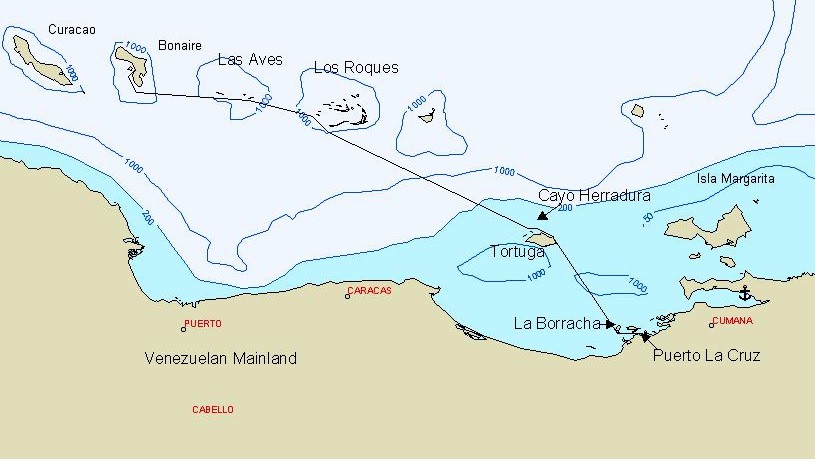
On leaving Puerto La Cruz, we headed to an anchorage on La Borracha island, about 10 miles away, so we could make an early start next day for La Tortuga. The island was very quiet with just a few day trippers on the beach and a fishing camp on the other side of the island. However, the anchorage was quite a small bay and our plan to have an early night and be rested for the long trip next day didn't work out! During the afternoon the wind piped up to 25 - 30 knots. We hoped it would ease at sunset but instead the wind howled until around midnight, forcing us to take anchor watches as we were worried about the reefs and shore not far behind us. Our anchor held fine and when we finally got to bed, we were further worried by the squeaks of the island's infamous vampire bats, which were flying around the boat! The bats have a reputation for nibbling the toes of sleeping yachtsmen and women! We weren't sorry to leave the island early next morning!
Despite a forecast of strong winds, we ended up motoring towards Tortuga until around 3 pm, when the winds finally picked up again. It seems to wait until we want to anchor somewhere! We anchored at La Caldera beach between a fishing boat and several other yachts. The island has miles and miles of golden beaches but no tourist development whatsoever. Next day we moved along the north coast of the island, to a small cay off the north west tip of Tortuga called Cayo Herradura. The small islet was beautiful, with a brilliant white sand beach of the softest sand we've ever seen. It was almost like walking through baking flour! Local fisherman had shacks on the beach and we were pleased to be able to help out a fisherman called Jesus, who had injured his knee and needed some painkillers and antibiotics. Luis, a young boy who was also camping on the island with his grandfather was desperate for new batteries for his radio and one of the other yachts was able to help. It must be very difficult for him living on such a small island with only adults for company and he was happy to join in with the cocktail party organised on the beach for all the other boats which were waiting at the island for a few days for the wind to drop off a little. It seems we're always waiting for more wind or less wind!
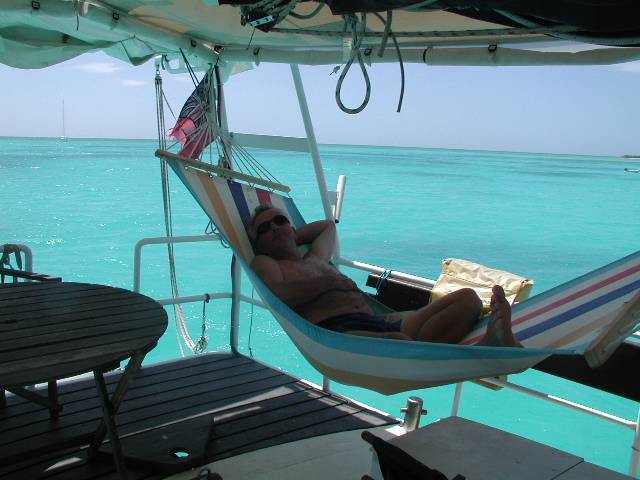
Waiting for the wind to drop!
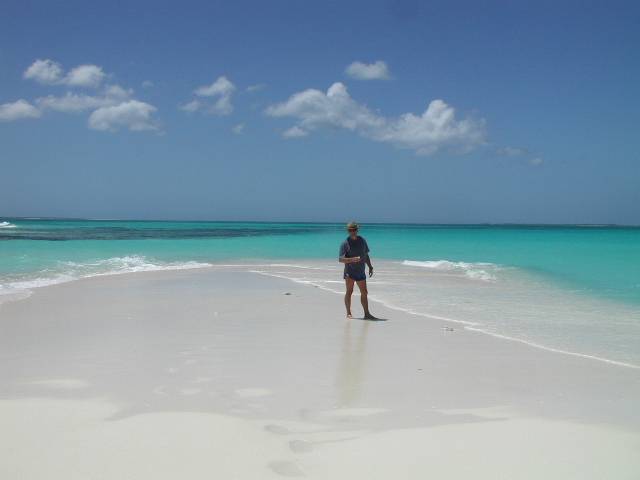
It's a tough old life!
When the weather forecast got a little better, we left Tortuga for the overnight passage to Los Roques, an Venezuelan National Park of reefs and small cays. The wind turned out to be stronger than forecast and the sea still choppy but as we were heading downwind it wasn't too bad. We made good time and by dawn we were alongside the eastern end of the archipelago. We decided to head on to the furthest west anchorage at Cayo de Agua. This turned out to be a mistake. The first anchorage we attempted, in the lee of the island's reef, meant motoring into 25 knots of wind through a narrow channel between reefs, so we decided it wasn't a good idea. We tried the other anchorages outside the island. One looked too scary to even approach and another in the lee of a reef further down was untenable in the swell. The only other anchoring options were miles back against the wind to the east and finally we realised we had no option but to carry on further west.
It was about 30 miles to Las Aves and we hoped to make it before dark, otherwise we'd be forced to carry on through the night again, to Bonaire. Of course, as we set off the wind decided to drop down considerably and finally we had to motor as well as sail, to keep our speed high enough to make the Aves before dark. We were relieved to arrive at Las Aves at around 5pm, when it was easy to pick our way into the anchorage through the reefs, which were clearly visible with the sun behind us. We were so happy to have found a protected, flat calm spot. We had large G & Ts and an early night!
After a good night's rest, we found that Las Aves was very beautiful. The Booby and Frigate birds, including fluffy white baby boobies, which give the archipelago it's name (meaning "the birds"), nested in the mangroves all around the anchorage. The water was lovely and clear. We took the dinghy through the reefs to the beach at the eastern end of the island and explored on foot a little and later snorkeled on the reef. The fishing opportunities were good too and Christine reeled in a good sized barracuda to the applause of some passing Venezuelan sports fishermen!
When we left for Bonaire, after a couple of days in Las Aves, we had some competition. We knew that friends on Apsara, a 58 foot Swan, were leaving a couple of hours behind us and wondered how quickly they'd catch up with us and overtake. Anju held her own remarkably well, considering her much shorter waterline and excess weight of Polar beer on board! We'd reached the south of the island of Banaire before we were overtaken and had a great opportunity to photograph each others' boats under sail.
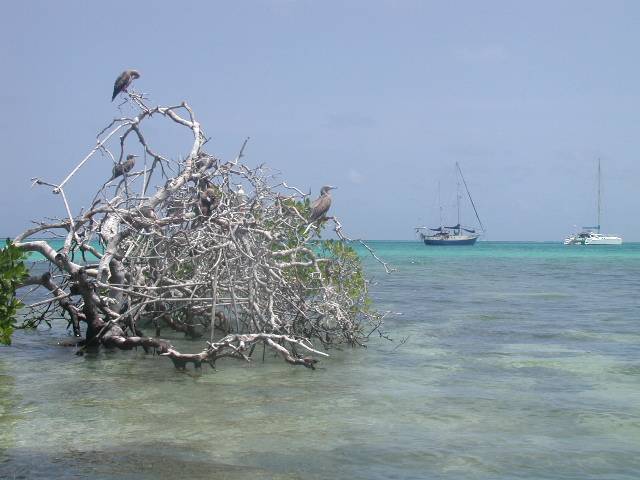
Happily anchored in Las Aves.
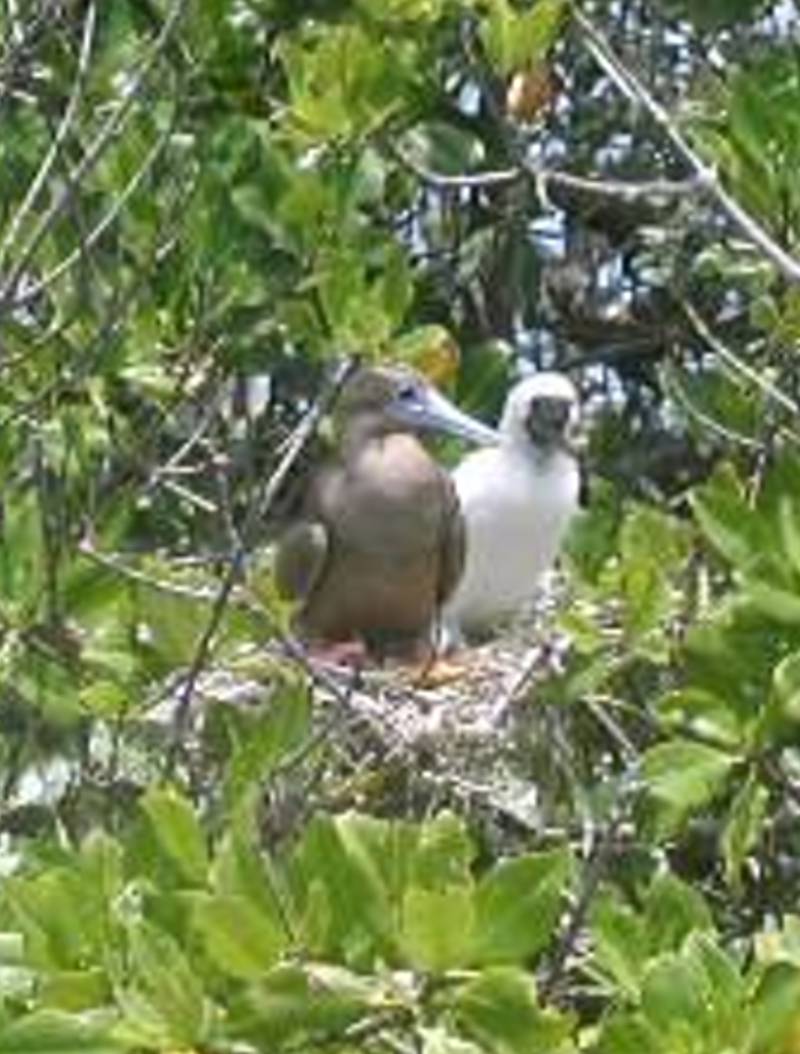
Booby family in Las Aves.
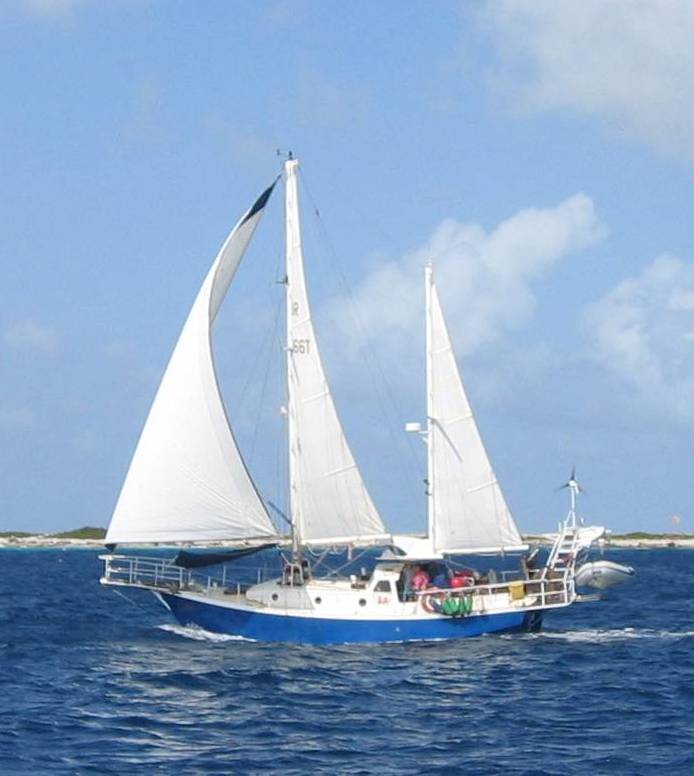
Anju racing her way along Bonaire's south coast.
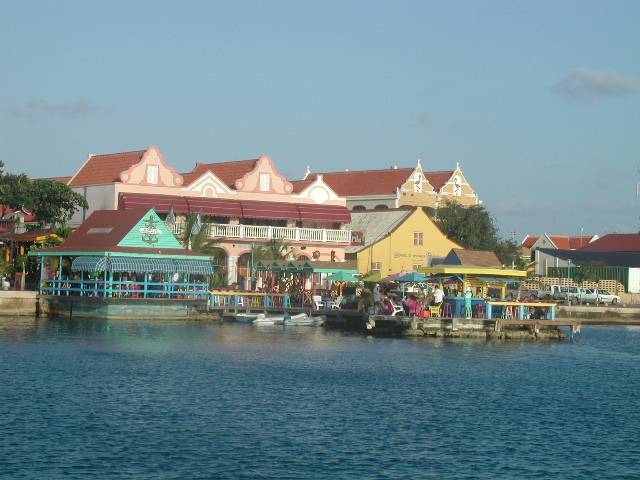
Anchored in Kralendijk, right in the heart of things.
Organised as ever, we arrived at Immigration at the Police Station with no pen to fill in the forms and there didn't seem to be a pen we could borrow in the whole Police Station, so we took the forms with us to the Tourist Information centre, who kindly lent us a pen and helped us understand the form which was in Dutch!
Phil bought some used diving gear from one of the dive centres there but had to buy a brand new bottle, as no used ones were available. It was a very good deal and enabled him to practice his diving skills, scraping a huge number of barnacles off the bottom of the boat! At least now we have diving gear aboard for emergencies.
Much of our time in Bonaire was spent doing more chores, re-waterproofing our spray hood in the cockpit, cleaning rust strains off the hull and finally constructing a comfortable seat on which to sit in the cockpit when on watch, ready for the long passage to Cuba. More supplies were taken on board - our shopping trolley was almost worn out and then we spent several days waiting - this time for there to be enough wind to leave for Cuba. Finally the forecast was good and we left Bonaire for the 680 mile passage to the north coast of Cuba.